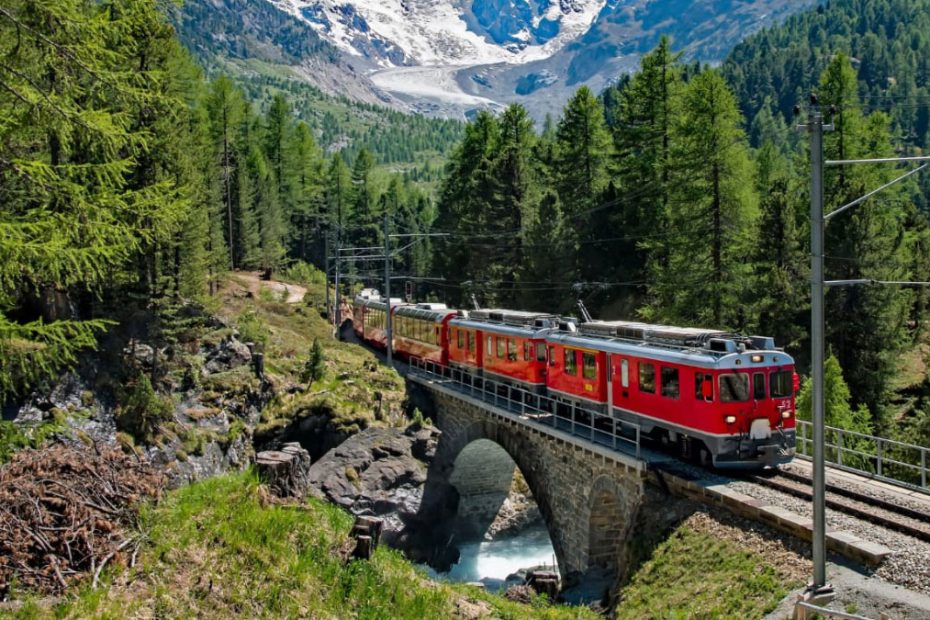Dreaming of exploring Europe by train but not sure where to start? Imagine gliding through picturesque landscapes, hopping from one iconic city to another, all while sticking to a budget. This 25-day European train itinerary will guide you through the best routes, must-see destinations, and essential tips to keep your costs in check.
Key Takeaways
- Strategic Budgeting and Cost Management: Consider using Interrail or Eurail passes for cost-effective train travel and book accommodations in advance to secure the best rates on hostels, budget hotels, and Airbnb rentals.
- Essential Packing Tips: Pack versatile clothing for varying weather, comfortable walking shoes, daily essentials, and all necessary electronics with chargers and adapters. Lightweight luggage is recommended for ease of travel.
- Important Documents and Travel Preparedness: Ensure your passport is valid, check visa requirements, carry train passes, and have comprehensive travel insurance. Keep digital or photocopies of crucial documents to avoid disruptions.
- Top Destinations and Highlights: The itinerary includes iconic cities like Paris, Amsterdam, Berlin, Prague, Vienna, Budapest, Ljubljana, Venice, and Rome, featuring major attractions, hidden gems, and suggested accommodations.
- Transportation Tips: Utilize local transport options such as metros, trams, and bike rentals. Choose sustainable travel methods like public transportation and cycling to reduce your carbon footprint.
- Money-Saving Strategies: Book train tickets in advance, evaluate the benefits of rail passes, find budget-friendly accommodations, and explore local markets for affordable dining options.

Preparing for Your 25-Day European Train Adventure
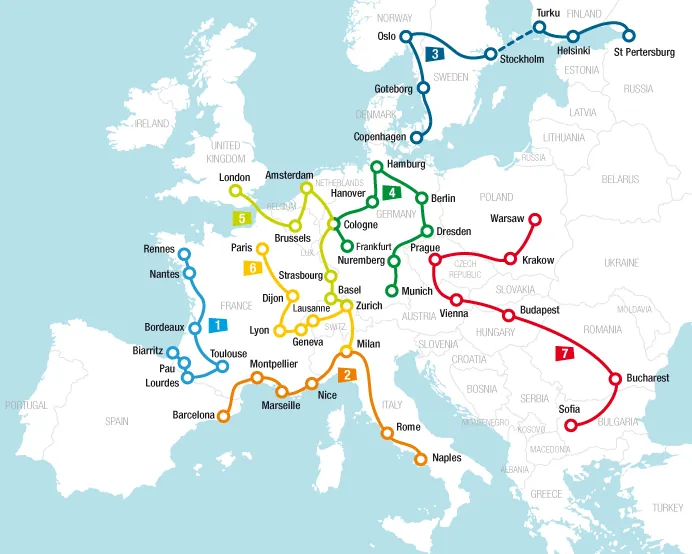
Planning a 25-day European train adventure involves strategic budgeting, practical packing, and ensuring you have all necessary documents. Each step is crucial for a smooth and enjoyable journey.
Budgeting and Cost Estimation
Several factors influence the cost of your 25-day European adventure by train.
Train Tickets and Passes:
- Consider an Interrail or Eurail pass, as these can be cost-effective for extensive train travel. For example:
| Pass Type | Duration | Youth (12-25 years) | Adults (26+ years) – 1st class | Adult Savers (26+ years) – 1st class (Group) |
|---|---|---|---|---|
| 15-day pass in 2 months | 15 travel days | $907 | $1,450 | $1,233 |
- Individual train tickets are also an option. Booking in advance can significantly lower costs. For example:
| Route | Approximate Cost |
|---|---|
| Amsterdam to Hamburg | €29 |
| Hamburg to Berlin | €29 |
| Berlin to Krakow | €39 |
Accommodation:
- Hostels are a budget-friendly choice for accommodation.
What to Pack
Packing smart is essential for a comfortable journey.
- Clothing: Bring versatile and layer-friendly clothing. Weather in Europe can vary greatly; lightweight, warm, and waterproof items are practical.
- Footwear: Comfortable walking shoes are crucial given the extensive walking involved in exploring cities.
- Essentials: Include a travel-sized first aid kit, toiletries, and a reusable water bottle.
- Technology: Don’t forget chargers, adapters, and a power bank for your electronics.
- Bags: Choose lightweight, durable luggage and a daypack for daily excursions.
Important Documents and Passes
Having the right documents helps avoid travel disruptions.
- Passport: Ensure your passport is valid for at least six months from your travel dates.
- Visas: Check entry requirements for each country on your itinerary.
- Train Passes: Carry your Interrail or Eurail pass. For individual tickets, print copies or have e-tickets accessible on a mobile device.
- Travel Insurance: Comprehensive travel insurance is essential for covering potential medical emergencies or travel interruptions.
- Photocopies: Keep photocopies or digital copies of all critical documents in case of loss or theft.
These steps are vital for your 25-day European train adventure, ensuring your journey is seamless and stress-free. Enjoy exploring the diverse landscapes and iconic cities that Europe offers.
The Itinerary Breakdown
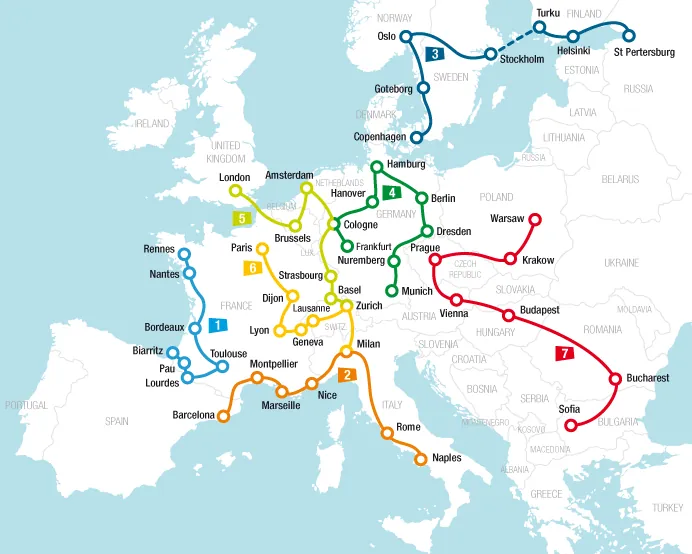
This 25-day journey takes you through Europe’s most iconic cities, blending rich history, vibrant culture, and stunning landscapes. Each destination offers unique experiences, and we’ve packed this itinerary with must-see attractions, hidden gems, and practical tips.
Day 1-3: Start In Paris, France
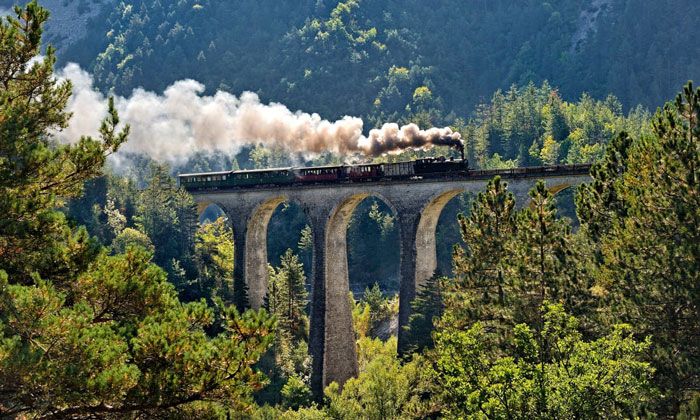
Paris, the City of Lights, welcomes you with its charm and elegance. Plan your visit in spring or fall for the best weather and fewer crowds.
Top Attractions:
- Eiffel Tower: Iconic monument with panoramic city views.
- Louvre Museum: Home to the Mona Lisa, the museum is a must-visit.
- Notre Dame Cathedral: Gothic architectural masterpiece.
Hidden Gems:
- Le Marais: Trendy district known for its boutiques and galleries.
- Canal Saint-Martin: Picturesque area perfect for a leisurely stroll.
Accommodations:
| Accommodation | Type | Cost per Night (Approx.) | Location | Amenities |
|---|---|---|---|---|
| Le Citizen Hotel | Boutique | €150 | Canal Saint-Martin | Free Wi-Fi, Breakfast |
| Generator Paris | Hostel | €35 | Gare du Nord | Bar, Terrace |
| Hotel des Grands Boulevards | Luxury | €200 | Opera Area | Rooftop Garden, Restaurant |
Dining Highlights:
- Le Comptoir du Relais: Renowned French bistro with seasonal dishes.
- L’As du Fallafel: Famous for its delicious falafel wraps.
- Pierre Hermé: Indulge in the city’s finest macarons.
Transportation & Practical Tips:
- Metro: Efficient for getting around; consider a Paris Visite travel pass.
- Bicycles: Bike rentals available for exploring the city.
- Sustainability Tip: Opt for public transport or cycling to reduce your carbon footprint.
Day 4-6: Amsterdam, Netherlands
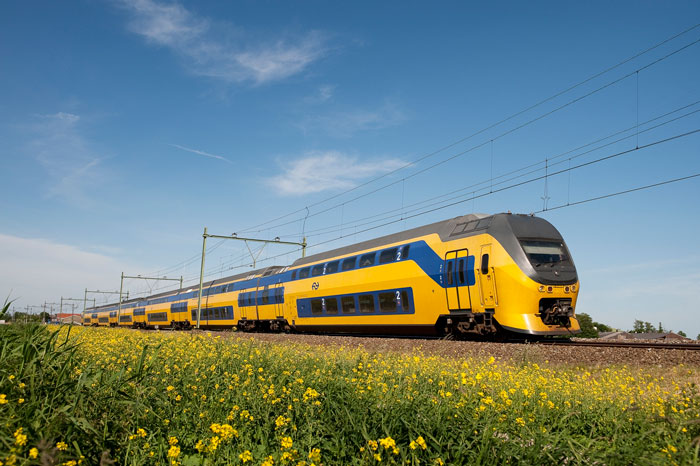
Amsterdam’s canals and historic charm make it a unique stop. Spring (tulip season) and early fall offer pleasant weather.
Top Attractions:
- Rijksmuseum: Dutch Golden Age masterpieces.
- Anne Frank House: Historic and moving museum.
- Van Gogh Museum: Extensive collection of the artist’s works.
Hidden Gems:
- Jordaan District: Quaint streets with cozy cafes and boutiques.
- Begijnhof: Tranquil courtyard hidden in plain sight.
Accommodations:
| Accommodation | Type | Cost per Night (Approx.) | Location | Amenities |
|---|---|---|---|---|
| The Hoxton | Boutique | €160 | Herengracht Canal | On-site Dining, Stylish Interiors |
| Stayokay Amsterdam | Hostel | €40 | Vondelpark | Bar, Café |
| Conservatorium | Luxury | €350 | Museum Quarter | Spa, Indoor Pool |
Dining Highlights:
- De Kas: Farm-to-table dining in a greenhouse setting.
- Snack Bar Van Geloven: Sample Dutch bitterballen.
- Stroopwafel Stands: Try freshly made stroopwafels at street markets.
Transportation & Practical Tips:
- Bicycles: Best way to explore the city’s bike-friendly streets.
- Trams: Convenient for longer distances.
- Sustainability Tip: Use bicycles for an eco-friendly way to see the city.
Day 7-9: Berlin, Germany
Berlin blends rich history with a cutting-edge art scene. Late spring and early summer provide the perfect climate for outdoor activities.
Top Attractions:
- Brandenburg Gate: Historic symbol of unity.
- Berlin Wall Memorial: Insight into the city’s divided past.
- Museum Island: UNESCO World Heritage site with five museums.
Hidden Gems:
- Hackesche Höfe: Courtyard complex with shops and restaurants.
- Teufelsberg: Abandoned Cold War listening station.
Accommodations:
| Accommodation | Type | Cost per Night (Approx.) | Location | Amenities |
|---|---|---|---|---|
| Michelberger Hotel | Boutique | €120 | Friedrichshain | Bar, Health Club |
| Generator Berlin Mitte | Hostel | €30 | City Center | Café, Bar |
| Hotel Adlon Kempinski | Luxury | €300 | Brandenburg Gate | Spa, Fine Dining |
Dining Highlights:
- Curry 36: Famous for currywurst.
- Markthalle Neun: Enjoy local foods at this indoor market.
- Zeit für Brot: Freshly baked bread and pastries.
Transportation & Practical Tips:
- U-Bahn: Extensive underground network.
- Cycles: Rent a bike to navigate Berlin’s vastness.
- Sustainability Tip: Choose public transit and reusable water bottles.
Day 10-12: Prague, Czech Republic
Prague’s fairy-tale charm includes medieval architecture and vibrant culture. May to September are ideal for visiting.
Top Attractions:
- Charles Bridge: Historic pedestrian bridge.
- Prague Castle: Largest ancient castle complex.
- Old Town Square: Home to the Astronomical Clock.
Hidden Gems:
- Vyšehrad: Offers panoramic views and historic sites.
- Letná Park: Great for picnics and river views.
Accommodations:
| Accommodation | Type | Cost per Night (Approx.) | Location | Amenities |
|---|---|---|---|---|
| The Emblem Hotel | Boutique | €130 | Old Town | Rooftop Spa, Restaurant |
| Czech Inn Hostel | Hostel | €20 | Vinohrady | Bar, Wi-Fi |
| Aria Hotel Prague | Luxury | €240 | Malá Strana | Music Library, Fine Dining |
Dining Highlights:
- Café Savoy: Historic café with a refined menu.
- Lokál Dlouhááá: Traditional Czech pub experience.
- Hemingway Bar: Known for exceptional cocktails.
Transportation & Practical Tips:
- Trams: Convenient for city center travel.
- Walking: Best way to explore the Old Town.
- Sustainability Tip: Support local eateries and shops.
Day 13-14: Vienna, Austria
Vienna’s imperial history and cultural richness make it a standout. Visit in late spring or early fall for milder weather.
Top Attractions:
- Schönbrunn Palace: Magnificent former imperial summer residence.
- St. Stephen’s Cathedral: Architectural marvel in the city center.
- Belvedere Palace: Houses an extensive art collection.
Hidden Gems:
- Hundertwasserhaus: Unique apartment house with colorful façade.
- Naschmarkt: A bustling food market.
Accommodations:
| Accommodation | Type | Cost per Night (Approx.) | Location | Amenities |
|---|---|---|---|---|
| 25hours Hotel | Boutique | €100 | MuseumsQuartier | Rooftop Bar, Sauna |
| Wombats City Hostel | Hostel | €25 | Naschmarkt | Bar, Lounge Area |
| Hotel Sacher Vienna | Luxury | €300 | City Center | Spa, Gourmet Dining |
Dining Highlights:
- Figlmüller: Renowned for its Wiener Schnitzel.
- Demel Café: Iconic for its Sachertorte.
- Naschmarkt: Variety of food stalls and eateries.
Transportation & Practical Tips:
- U-Bahn: Comprehensive underground system.
- Cycling: Bike-sharing programs available.
- Sustainability Tip: Frequent local markets for fresh and local products.
Day 15-17: Budapest, Hungary
Budapest combines historic grandeur with modern vibrancy. Summer offers warm weather for river cruises and outdoor baths.
Top Attractions:
- Buda Castle: UNESCO site with stunning views.
- Parliament Building: Impressive Neo-Gothic architecture.
- Széchenyi Thermal Bath: One of the largest spa complexes in Europe.
Hidden Gems:
- Fisherman’s Bastion: Offers panoramic views of the Danube.
- Ruin Bars: Trendy bars set in abandoned buildings.
Accommodations:
| Accommodation | Type | Cost per Night (Approx.) | Location | Amenities |
|---|---|---|---|---|
| Brody House | Boutique | €90 | Palace District | Bar, Art Gallery |
| Maverick City Lodge | Hostel | €15 | Jewish Quarter | Bar, Lounge |
| Four Seasons Gresham Palace | Luxury | €380 | Chain Bridge | Spa, Fine Dining |
Dining Highlights:
- New York Café: Lavish historic café known as the ‘most beautiful café in the world.’
- Központ Bisztró: Classic Hungarian dishes.
- Gerbeaud: Famous pastry shop.
Transportation & Practical Tips:
- Metro: Efficient for seeing major sites.
- Trams: Scenic routes along the Danube.
- Sustainability Tip: Use refillable water bottles and avoid single-use plastic.
Day 18-20: Ljubljana, Slovenia
Ljubljana’s green spaces and rich culture are perfect for laid-back exploration. Late spring to early fall are the most pleasant times to visit.
Top Attractions:
- Ljubljana Castle: Offers history and great city views.
- Tivoli Park: Expansive park perfect for leisurely walks.
- Triple Bridge: Architectural landmark connecting the city’s central parts.
Hidden Gems:
- Metelkova: Alternative culture center in former military barracks.
- Dragon Bridge: Iconic with dragon statues.
Accommodations:
| Accommodation | Type | Cost per Night (Approx.) | Location | Amenities |
|---|---|---|---|---|
| Vander Urbani Resort | Boutique | €120 | Old Town | Rooftop Pool, Restaurant |
| Hostel Celica | Hostel | €25 | Metelkova | Bar, Art Gallery |
| Antiq Palace Hotel | Luxury | €200 | City Center | Spa, Courtyard |
Dining Highlights:
- Stara Gostilna: Traditional Slovenian cuisine.
- Druga Violina: Offers locally sourced dishes.
- Cacao: Renowned for desserts and coffee.
Transportation & Practical Tips:
- Bicycles: Available for rent, ideal for city exploration.
- Walking: Central attractions are within walking distance.
- Sustainability Tip: Choose locally owned businesses for eco-friendly travel.
Day 21-23: Venice, Italy
Venice, with its canals and history, offers a romantic and unique experience. Spring and fall provide pleasant weather without summer crowds.
Top Attractions:
- St. Mark’s Basilica: Iconic cathedral with impressive mosaics.
- Doge’s Palace: Rich in history and art.
- Grand Canal: Best explored by gondola.
Hidden Gems:
- Dorsoduro District: Artsy area with fewer tourists.
- Scuola Grande di San Rocco: Filled with Tintoretto artworks.
Accommodations:
| Accommodation | Type | Cost per Night (Approx.) | Location | Amenities |
|---|---|---|---|---|
| Ca’Sagredo Hotel | Boutique | €220 | Grand Canal | Rooftop Terrace, Restaurant |
| Generator Venice | Hostel | €30 | Giudecca Island | Bar, Lounge |
| Aman Venice | Luxury | €550 | Grand Canal | Spa, Garden |
Dining Highlights:
- Osteria Da Fiore: Michelin-starred with Venetian cuisine.
- Cantina Do Mori: Historic wine bar open since 1462.
- Gelato Fantasy: Known for delicious gelato.
Transportation & Practical Tips:
- Vaporetto: Water buses essential for getting around.
- Walking: Best way to explore the narrow streets.
- Sustainability Tip: Reduce waste by using reusable water bottles.
Day 24-25: Rome, Italy
Rome’s historical and architectural treasures make it a fitting finale. Visit in spring or fall to avoid peak tourist seasons.
Top Attractions:
- Colosseum: Iconic symbol of ancient Rome.
- Vatican Museums: Includes the Sistine Chapel.
- Trevi Fountain: Tradition of throwing a coin for good luck.
Hidden Gems:
- Aventine Hill: Offers spectacular city views.
- Villa Borghese Gardens: A peaceful retreat.
Accommodations:
| Accommodation | Type | Cost per Night (Approx.) | Location | Amenities |
|---|---|---|---|---|
| Villa Spalletti Trivelli | Boutique | €200 | Quirinale | Spa, Garden |
| The Beehive | Hostel | €50 | Termini | Café, Lounge |
| Hotel Eden | Luxury | €400 | Ludovisi | Rooftop Bar, Fine Dining |
Dining Highlights:
- Roscioli: Fresh pasta and classic Roman dishes.
- Bonci Pizzarium: Famous for unique pizza al taglio.
- Gelateria dei Gracchi: Highly rated for artisanal gelato.
- Metro: Efficient for major attractions.
- Walking: Best for exploring central historic areas.
- Sustainability Tip: Use public transport and support local businesses.
Tips for Saving Money

To make your 25-day European train adventure more affordable, consider these practical tips.
Booking Tickets in Advance
Purchasing train tickets in advance can yield significant savings. Many rail companies offer discounts for early bookings. For instance, booking routes like Amsterdam to Paris several months ahead of your departure can save up to 50% compared to last-minute purchases. Use websites like Rail Europe or Trainline to compare prices and secure your tickets early.
Using Rail Passes
Evaluate if a rail pass suits your itinerary. A GLOBAL Eurailpass costs around $900 for up to two months of travel. It provides unlimited travel across 33 European countries, which offers convenience for extensive journeys. But, analyze your specific route, as individual tickets might save more for shorter or non-consecutive travel periods. Also, note that certain countries like Poland aren’t included in some passes, so consider your destinations carefully.
Finding Budget Accommodations
Accommodation can be one of the biggest expenses during your trip. Opt for budget-friendly options like hostels, budget hotels, and Airbnb rentals. Hostels are particularly affordable in cities like Berlin and Krakow, offering dormitory beds for as low as €15 per night. Use platforms such as Hostelworld and Booking.com to compare prices. Consistently read reviews to ensure quality and safety while maintaining your budget.
| Location | Hostel Price (Per Night) | Budget Hotel Price (Per Night) | Airbnb Price (Per Night) |
|---|---|---|---|
| Amsterdam | €30 | €70 | €50 |
| Paris | €35 | €80 | €60 |
| Berlin | €15 | €60 | €40 |
| Krakow | €10 | €50 | €30 |
| Prague | €20 | €55 | €35 |
By planning accommodation alongside rail tickets, you leverage both cost and convenience, ensuring a smoother journey through Europe.
Essential Travel Tips
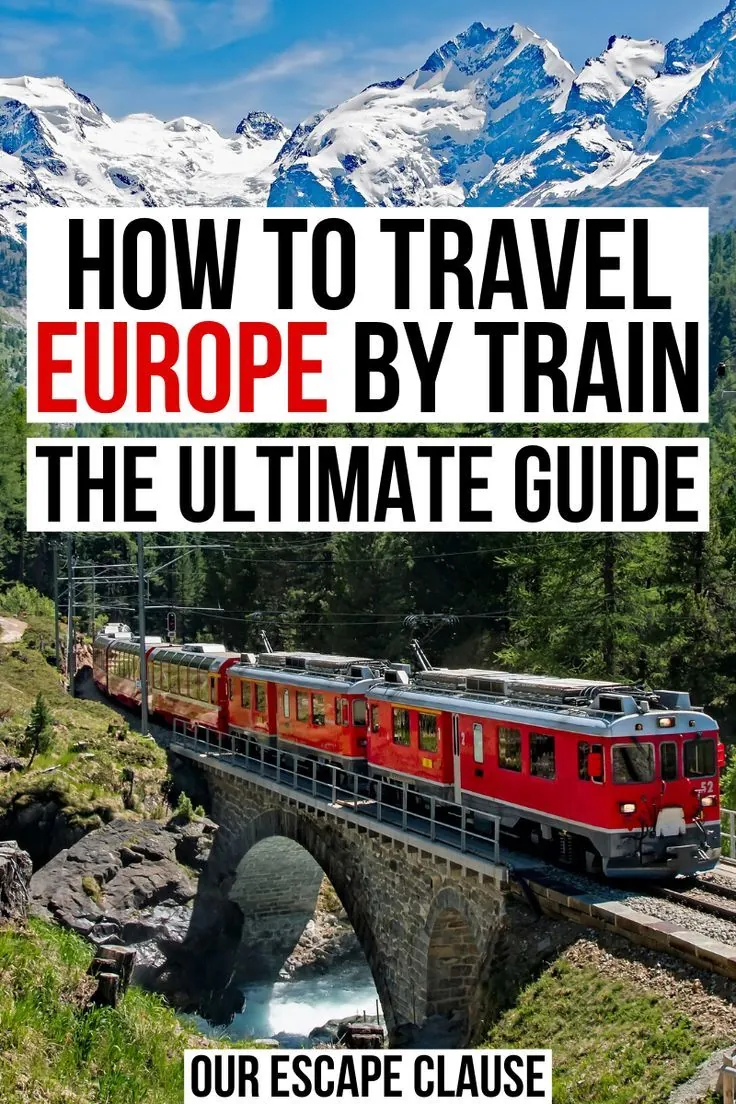
Exploring Europe by train offers an exciting and affordable way to experience the continent. Use these essential tips to ensure you have a smooth and enjoyable journey.
Exploring European Train Stations
Understand Train Layouts: Train stations in Europe, such as Gare du Nord in Paris and Stazione Termini in Rome, can be vast with multiple platforms. Check station layouts online beforehand to avoid getting lost.
Arrive Early: Arrive at least 30 minutes before your train’s departure. This time allows you to locate your platform, validate your ticket, and deal with any last-minute issues.
Use Station Services: Take advantage of services like luggage storage and Wi-Fi, which are available in major stations like Berlin Hauptbahnhof. This makes exploring nearby attractions more convenient.
Language Assistance: Learn essential phrases in the local language, or use a translation app. Many stations have signage in multiple languages, but knowing basic terms speeds up navigation.
Staying Safe While Traveling
Keep Valuables Secure: Use anti-theft backpacks and keep your passport, tickets, and money close. Pickpocketing is common in busy stations like Barcelona Sants.
Stay Informed: Follow local news and travel advisories for updates on strikes or delays. Apps like Rail Planner provide real-time information for European trains.
Travel Insurance: Purchase travel insurance covering train travel. This can help with unexpected cancellations or medical situations.
Avoid Late-Night Arrivals: Try to schedule arrivals during daylight hours, particularly in unfamiliar cities. Major stations like Budapest Keleti have better security during the day.
Making the Most of Short Stops
Plan Ahead: Research layover destinations and prioritize must-see spots. For instance, if you have a layover in Zurich, visit the nearby Old Town and Lake Zurich.
Use Lockers: Store your luggage in station lockers to move freely. Most major train stations, such as Amsterdam Centraal, offer this facility.
Local Cuisine: Take the time to savor local dishes. Try traditional Belgian waffles in Brussels or a quick pizza slice in Naples.
Efficient Transport: Use local transport options like trams or buses to get around quickly. Cities like Vienna and Prague have well-connected public transportation systems that make short visits manageable.
By following these essential tips, you can navigate European train stations effortlessly, stay safe, and make the most of your short stops, ensuring a memorable and enjoyable 25-day adventure across Europe.
Conclusion
Embarking on a 25-day European train journey offers an unforgettable experience filled with iconic cities, breathtaking landscapes, and rich cultural encounters. By strategically planning your itinerary, budgeting wisely, and packing efficiently, you can maximize both your time and money. Utilizing rail passes, booking in advance, and choosing budget-friendly accommodations ensures you stay on track financially.
Remember to keep your documents in order and consider travel insurance for peace of mind. With these tips and a sense of adventure, you’re well-prepared to explore Europe by train, creating memories that will last a lifetime. Happy travels!
Frequently Asked Questions
What is the best way to travel Europe on a budget?
Traveling Europe on a budget is best achieved via train. Use Interrail or Eurail passes for unlimited travel, and book individual train tickets in advance. For accommodations, consider hostels, budget hotels, or Airbnb rentals.
Why should I consider using an Interrail or Eurail pass?
Interrail and Eurail passes offer unlimited train travel across Europe for a fixed period, providing flexibility and cost savings. They allow you to explore multiple countries without worrying about individual ticket costs.
How can I save money on accommodation in Europe?
To save money on accommodation, opt for hostels, budget hotels, or Airbnb rentals. Booking accommodations in advance and during off-peak seasons can also help lower costs.
What essential documents do I need for a European train trip?
You will need a valid passport, any necessary visas, travel insurance, and your train tickets or travel pass. Always check the entry requirements of each country on your itinerary.
What should I pack for a 25-day train trip through Europe?
Pack versatile clothing suitable for various weather conditions, comfortable footwear, toiletries, and essential travel items like adapters and portable chargers. A secure, durable backpack or suitcase is also recommended.
Are there any safety tips for traveling by train in Europe?
Yes, keep your valuables secure, stay informed about local news, and purchase travel insurance. Arrive early at train stations and be aware of your surroundings.
How early should I book train tickets in Europe?
Book your train tickets as early as possible, ideally several months in advance, to secure the best prices and availability, especially for popular routes.
What are some budget-friendly destinations included in the itinerary?
The itinerary covers cities like Berlin, Prague, Budapest, and Ljubljana, known for their affordability compared to other European capitals like Paris and Rome.
Are there tips for making the most of short stops between cities?
Plan ahead, utilize luggage lockers at stations, savor local cuisine quickly, and use efficient local transport to explore key attractions without delay.
Is travel insurance necessary for a European train trip?
Yes, travel insurance is essential to cover unforeseen events like medical emergencies, trip cancellations, or lost belongings, ensuring a smoother and worry-free journey.

